Living cells can perceive and respond to the geometry of their environment. “Cells sense and respond to the geometry of the surfaces they are exposed to. Depending on their curvature, surfaces can either encourage cells to create new tissue or prevent them from doing so,” says Amir Zadpoor, professor of Biomaterials and Tissue Biomechanics, supervisor of a study showing that the curvature of biomaterials inhibits or stimulates bone cells to make new tissue. “Stimulating curvatures made by a 3D printer are an easy and safe way to promote tissue growth. As compared to drugs, they are also much cheaper.”
In petri dishes, the researchers grew bone cells surrounded by small molds made from biomaterials with which the researchers have experience. Depending on the curvatures in the molds, the cells tended to grow, divide, and form tissue to different extents.
Although curved shapes seem to exist in endless variations, they always fall roughly into one of these three categories: a ball that has a convex curvature, a saddle that has a concave curvature, and a plate that is flat. One of the authors, assistant professor of Biomaterials Lidy Fratila-Apachitei, said, “Cells prefer a saddle shape. If they perceive a saddle shape nearby, growth is stimulated. The study also shows that cells prefer valleys over hills.”
First author Sebastien Callens did the experiments and analysis in the study. “Cells also have a skeleton, which consists of fibers that are under tension to different degrees. How tension builds up in those fibers strongly influences the behavior of cells. Our study shows that cells collectively align their stress fibers with the curvatures they experience to minimize their need to bend. I could see that cells prefer to align than to bend.”
You can’t have only saddle curves around cells. Just as the three angles of a triangle always add up to 180 degrees, the sum of all curvatures must also equal some fundamental numbers. “You always have a limited budget of saddle shapes,” says Zadpoor. “If you use too much negative curvature somewhere, you must use positive curvatures somewhere else to keep the sum constant. You need to use your budget wisely to encourage maximum tissue regeneration.”
The study provides guidance on the optimal geometry of biomaterials and implants to maximize tissue regeneration. The complex geometric designs required are made using high-precision 3D printing techniques to make the shapes so small that they are perceptible to cells. Callens stated, “We have now discovered new playing rules by which biomaterials can stimulate tissue growth. In follow-up research, we will try to apply those rules optimally.”
More information:
Sebastien J. P. Callens et al, Emergent collective organization of bone cells in complex curvature fields, Nature Communications (2023). DOI: 10.1038/s41467-023-36436-w
Provided by
Delft University of Technology
Citation:
Curvature of biomaterials inhibits or stimulates bone cells to make new tissue, offering insights for repair (2023, March 3)
